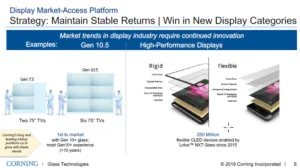 Chris Hudson is from Corning where he is International Division VP and Commercial Director and he talked what Corning likes to describe as the current ‘glass age’. The company is 165 years old and has 46,000 employees worldwide with revenues of $10.3 billion. It has been in the display industry for 90 years!
Chris Hudson is from Corning where he is International Division VP and Commercial Director and he talked what Corning likes to describe as the current ‘glass age’. The company is 165 years old and has 46,000 employees worldwide with revenues of $10.3 billion. It has been in the display industry for 90 years!
The company has an distinctive innovation recipe, Hudson said. It looks for tough challenges and finding tough solutions. However, they have to be cost effective and that means keeping close to customers. 8% to 10% of its revenue is invested into R&D, about twice the level of the 1000 most innovative companies.
Corning was one of the first suppliers for LCD substrates in 1993, but R&D started much earlier and it invented the fusion process that it uses for large substrates in 1963. It has been the first to new sizes and thicknesses and recently opened the world’s first G10.5 glass plant in Hefei, China.
The company depends on three core technologies, glass, ceramic and optics, four manufacturing process and five markets. It puts 8% of its R&D into projects that exploit at least two of those areas.
G10.5 can make six up 75″ LCDs or eight up 65″ LCD panels so are very attractive for making large TVs (for more detail see BC05 Applied Materials Explains Boost in Capex). Corning has been making G10 glass for quite a long time now (with Sharp of course). Lotus NXT is the Corning substrate for flexible OLED manufacture. Hudson was the first speaker to mention automotive applications in the confernce, although big TVs are the main consumers of glass by area, of course.
The two people shown holding the substrate may be “the most photoshopped people in history”, one wag suggested!
Corning is seeing lots of capacity expansion at G10.5. Corning thinks the industry needs around one G10.5 fab per year – more than that will lead to oversupply. Oxide TFT substrates will be more important for TV as the demand for high resolution gets more important. Making higher resolution with oxide TFTs needs better glass. Corning expects significant 8K market growth by 2021.
There is also a move to slimmer sets and the use of Corning’s Iris glass for lightguide plates. Monitor makers (HP & Dell have launched products) are also looking at making thinner and brighter monitors using the glass.
The latest version, Gorilla Glass V is said to have an 80% chance of surviving a drop from 1.6 metres and Corning will have the next level of the glass “later in 2018”. Glass has moved onto the back of the phone as well as the front, but it can also be used as a cover glass for smartwatches (Hudson claimed that it has 70% better damage performance compared to sapphire).
The company sees a lot of applications in the automotive market and is also working on high index glass for the optics in AR and VR. High purity fused silica is a special kind of glass and is used in 3D sensing (it has almost zero coefficient of thermal expansion) and is in every phone that uses facial recognition, Hudson said.

